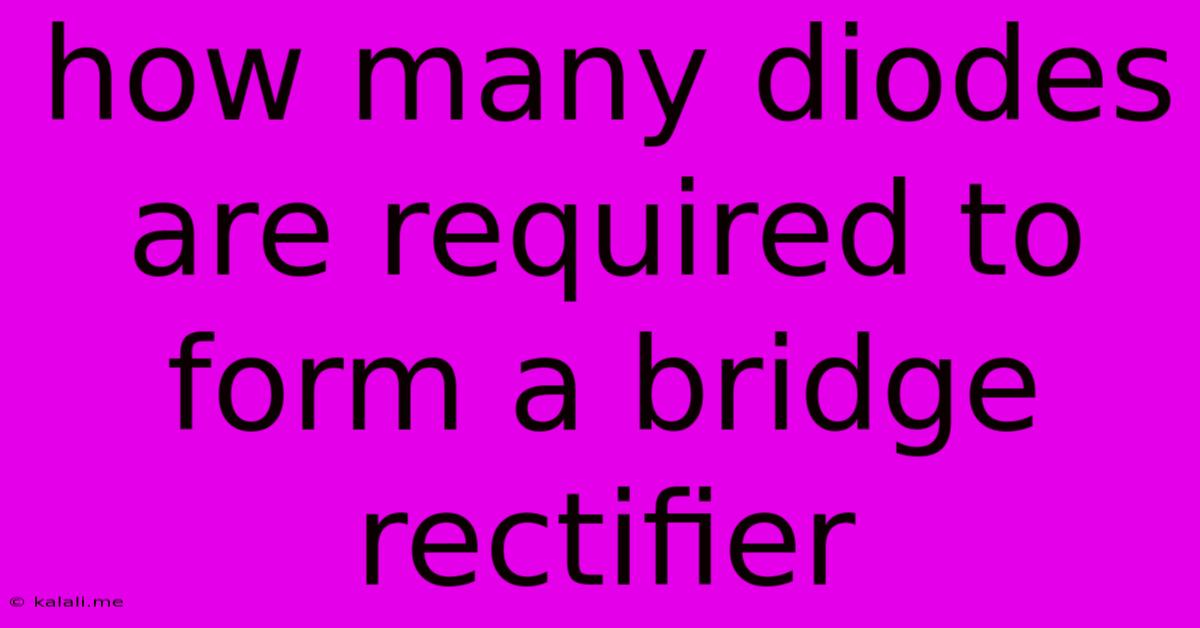How Many Diodes Are Required To Form A Bridge Rectifier
Kalali
Jun 12, 2025 · 2 min read

Table of Contents
How Many Diodes Are Required to Form a Bridge Rectifier?
A bridge rectifier is a crucial component in many power supply circuits, converting alternating current (AC) to pulsating direct current (DC). But how many diodes does this essential circuit require? This article will explore the answer, explaining the function of each diode and the overall operation of a bridge rectifier.
Understanding the Bridge Rectifier's Function
The primary function of a bridge rectifier is to rectify an AC input signal, meaning it converts the alternating positive and negative cycles into a unidirectional current. This unidirectional current, while still pulsating, can then be further smoothed using capacitors and filters to produce a relatively stable DC output. This is essential for powering electronic devices that require a stable DC voltage.
The Essential Four Diodes
The answer to the question, "How many diodes are required to form a bridge rectifier?" is four. These four diodes are arranged in a specific configuration to ensure that current flows in only one direction, regardless of the polarity of the input AC signal.
How the Diodes Work Together
Let's break down the role of each diode during the AC cycle:
- During the positive half-cycle: Two diodes conduct, allowing current to flow through the load in one direction.
- During the negative half-cycle: The other two diodes conduct, again allowing current to flow through the load in the same direction.
This clever arrangement ensures that the current always flows through the load in the same direction, even though the input voltage is constantly changing polarity. Without this arrangement, half of the AC waveform would be lost. This is why a half-wave rectifier, which only uses one or two diodes, is less efficient.
The Bridge Rectifier Diagram
A simple diagram can illustrate this better. Imagine a diamond shape with a diode on each side. Each diode is labeled D1, D2, D3, and D4. The AC input is connected to two opposite corners of the diamond, while the DC output is taken from the other two opposite corners. During each half-cycle, a pair of diodes conducts, passing current through the load. The other two diodes are reverse-biased and block current flow in the opposite direction.
Alternative Configurations?
While a four-diode bridge rectifier is the most common and efficient configuration, there are some less common variations. However, these rarely offer any practical advantages and are generally more complex to design and implement. The standard four-diode bridge remains the preferred choice due to its simplicity and effectiveness.
Conclusion: Four Diodes are Key
In conclusion, a bridge rectifier requires four diodes to effectively convert AC to pulsating DC. This configuration ensures maximum efficiency by utilizing both the positive and negative half-cycles of the AC input, resulting in a smoother and more usable DC output. This makes it an indispensable component in countless electronic circuits.
Latest Posts
Latest Posts
-
Which Of The Following Occurs In Meiosis But Not Mitosis
Jun 13, 2025
-
Which Of The Following Diseases Are Caused By Viruses
Jun 13, 2025
-
Density Of Water At 4 C
Jun 13, 2025
-
Words To Describe A Good Mom
Jun 13, 2025
-
Electron Volt Is A Unit Of
Jun 13, 2025
Related Post
Thank you for visiting our website which covers about How Many Diodes Are Required To Form A Bridge Rectifier . We hope the information provided has been useful to you. Feel free to contact us if you have any questions or need further assistance. See you next time and don't miss to bookmark.